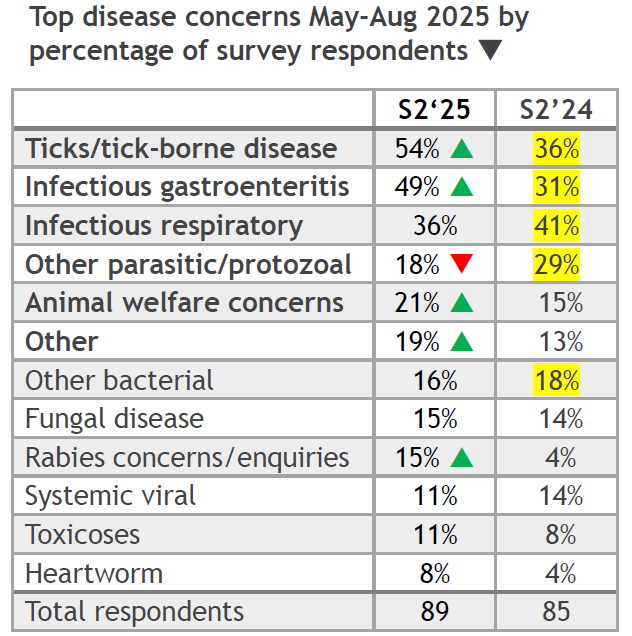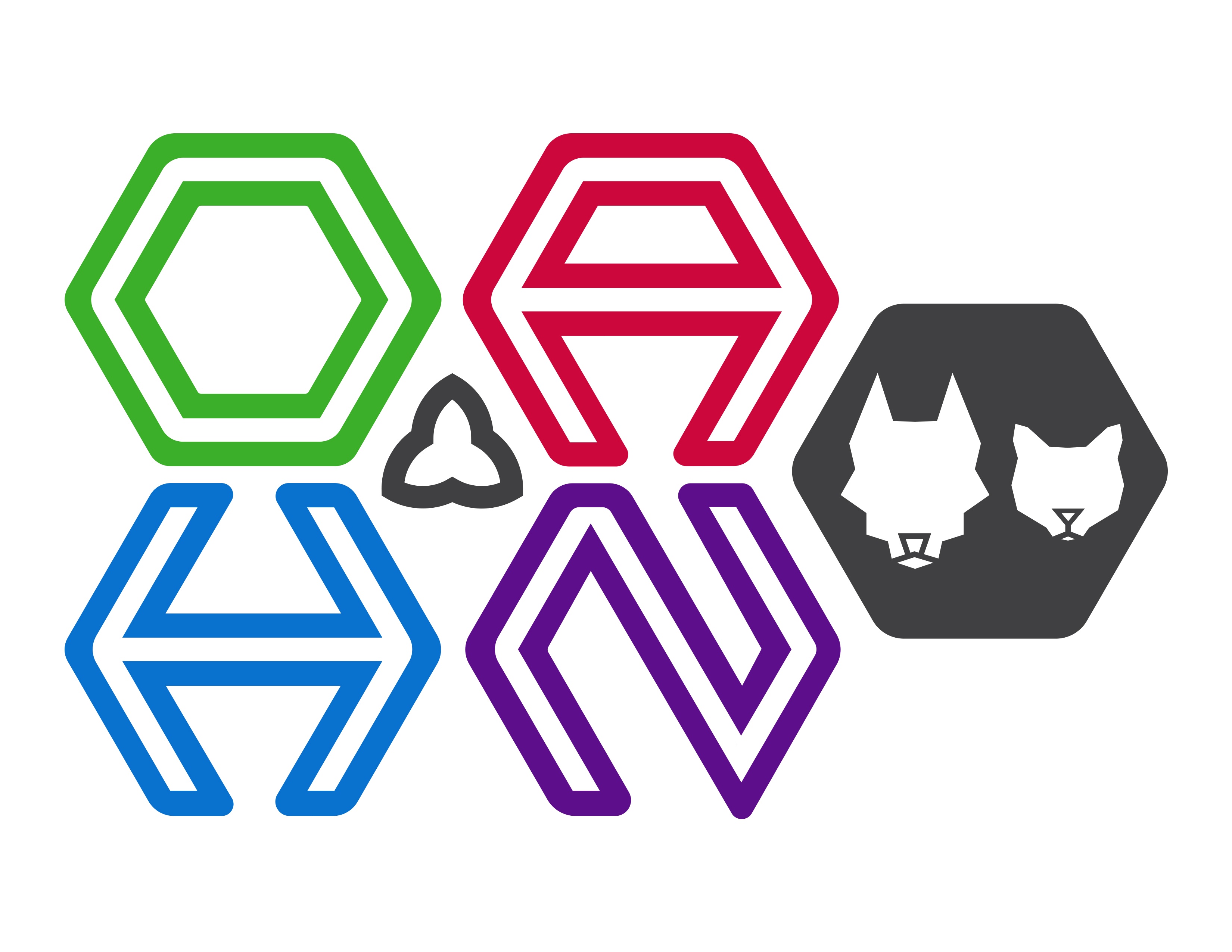Ontario Animal Health Network (OAHN)
Companion Animal Network Team
Veterinary Need-2-Know (N2K) Update – May-Aug 2025
OAHN summer survey and lab data: Key results
There were 89 survey respondents from 47 counties, including primary care, referral, mobile and emergency practices. Survey responses included a number of comments about increased cases of undifferentiated vomiting and diarrhea (don’t forget to check out the ENOVAT guidelines for antimicrobial use in canine acute diarrhea as well as their quick reference infographic) and especially about increased allergies and skin infections, possibly related to the high heat and humidity (don’t forget about the new ISCAID antimicrobial use guidelines for canine pyoderma, including surface, superficial and deep). The weather likely also contributed to a rash of fatal cases of upper airway obstruction in brachycephalic dogs observed at the Animal Health Lab.
 Rocky Mountain Spotted Fever: Long Point
Rocky Mountain Spotted Fever: Long Point
At least 8 confirmed cases of RMSF (Rickettsia rickettsii) in dogs and 2 cases in people who visited Long Point ON over the summer have been detected. Results of recent tick dragging to confirm infection in local ticks are expected any time. It is difficult to predict how fast this pathogen could spread in Ontario given the wide distribution of the presumed vector here, Dermacentor variablilis. Only 32% of OAHN survey respondents were actively asking clients about travel to this area, and 27% were not yet aware of the outbreak. Tick checks are especially crucial because the pathogen transmits relatively quickly once ticks attach, so common tick preventatives may not provide effective protection.
Vaccine-strain canine distemper cases
Post mortem examination of two puppies from two different litters (one unvaccinated, one vaccinated as early as 4 weeks of age) confirmed disease due to the Rockborn vaccine strain of canine distemper virus. A similar vaccine strain-associated case was detected in an Ontario puppy in 2023.
In June, authorities in New Zealand implemented a prohibition on the use of one particular canine distemper vaccine after a series of vaccine-induced distemper in 16 puppies over the previous 4 years, while they complete a reassessment of the product (which was voluntarily withdrawn by the manufacturer). However they emphasize that vaccination remains an important component of managing canine health, and distemper vaccination has helped create the current non-endemic status of the disease in the country.
This serves as a reminder of the possibility of reversion to virulence when using modified-live vaccines, and the importance of reporting adverse events and apparent break-through infections to manufacturers.
If you see highly unusual cases or clusters of animals with potentially infectious diseases, you can share the details with OAHN quickly and easily via our companion animal disease reporting portal. All submissions are reviewed by members of the network team to detect any notable disease patterns and occurrences that should be communicated to Ontario veterinarians.
Rabies update: Bats bats bats bats
Forty-nine rabid bats were detected in Ontario in August alone, with the total number for the year at a record-breaking 98 so far, but with a percent-positivity lower than in 2024. The tragic case of bat rabies in an Ontario resident last year has no doubt contributed to increased awareness of the risks from bats (which is good), but unfortunately has likely also contributed to excessive fear regarding the true risk of transmission from bats when there is no direct contact. OAHN has therefore produced a handy bat contact guide to help discern what is and is not a rabies risk (for pets and people) when it comes to bats.
The last case of raccoon variant rabies in Ontario was detected in 2023. The last case of fox variant rabies in southern Ontario was detected in 2018, but it remains endemic in the north. The MNR once again successfully completed its rabies baiting and control operations in southern Ontario. Assuming no new detections, next year control efforts will return to focusing on high-risk areas along the border with New York State. A rabid fox kit was detected in the Ottawa area this summer, but typing confirmed it was a bat strain of the virus – an important reminder that spillover infections of any strain can occur in any mammal.
Veterinarians seeking assistance with risk assessments, sample submission and post-exposure management guidance for domestic animals can reach OMAFA via the rabies response request form on the Rabies: Information for Veterinarians webpage!
Salmonella in people: Dog food / treats link
The Public Health Agency of Canada recently posted a notice about an ongoing investigation into salmonellosis cases in people linked to handling of dog food and treats. Since February 2025, there have been 27 confirmed cases of a fairly specific strain of Salmonella Oranienburg across Canada, primarily out west but one case was found in Ontario. The report simply states that many people who became sick reported handling dog food or treats, including kibble, dehydrated and freeze-dried treats.
It may be difficult to pinpoint an exact source of the Salmonella in this outbreak, especially if there was contamination of batches of treats or food that have already been consumed. It is an important reminder of the potential risks to people from handling these products – especially raw products, even if they have been preserved by various methods (check out the OAHN infosheet on RMBDs). Basic hand and household hygiene practices can protect pet owners from serious illness.
CAPCvet graphs
CAPCvet.org publishes monthly maps based on serological and fecal testing of select pathogens in dogs and cats by some of the major diagnostic labs in the US and Canada. Although the data only represent a fraction of the testing done in each area (estimated at approximately 30%), they still provide useful insight into local parasite activity. OAHN also posts graphs of these data for Ontario to help visualize trends over time. Check them out!
Nasty & noteworthy parasites
A dog in Oxford county developed spontaneous pneumothorax that was found to have been caused by infection with the lung fluke, Paragonimus kellicotti. A small number of such cases was detected in Ontario in 2021-2022 (check out the OAHN infosheet on P. kellicotti), but infection appears to be very uncommon in clinically normal animals. An additional 30-some healthy dogs on the same property, all with outdoor lifestyles and potential exposure to small prey, were screened for lung flukes and were all negative, but testing did detect one dog shedding Echinococcus multilocularis (EM).
An unusual case of EM was also detected in Niagara in a clinically normal 10-week-old kitten. Cats are known but very uncommon definitive hosts for this parasite compared to dogs and wild canids. The kitten was tested as part of a routine check up after being acquired through Kijiji, but it is presumed the kitten was from the same region, which is one of the higher risk areas for EM in Ontario.
One more nasty parasite for which veterinarians need to be on the lookout is New World Screwworm (NWS, Cochliomyia hominivorax). After being eradicated from the southern US and Mexico decades ago, this parasite is once again nearing the US border. Although there is currently no risk of the parasite establishing itself further north due to climate, it is important to identify in imported / travelling animals, as the maggots destroy living tissue and can cause significant damage. It is also critical to alert authorities at the pet’s point of origin if it came from a non-endemic area in the south.
H5N1 flu: Still here
Although it was a relatively quiet summer in Ontario with regard to H5N1 influenza, activity is already increasing in other parts of Canada as the fall bird migration gets underway. The virus has yet to be detected in any dairy herds outside of the continental US, and no trace of the virus has been found in over 5600 samples of raw milk from 2700 dairy farms across Canada. Case reports of severe illness due to H5N1 influenza infection in cats continue to trickle in from the US as well, particularly in association with consumption of raw milk or raw meat-based diets (including commercially available diets).
Companion animal veterinarians must maintain vigilance for this virus, particularly in cats that are acutely ill and have potential direct or indirect contact with infected animals or potentially contaminated products. Promote testing in these patients, and make use of the NEW! OAHN guide to Influenza A diagnostic testing in Ontario for cats, dogs and exotics. Surveillance testing is also available for eligible cats (including barn cats and other outdoor cats) through the OAHN AIV in feral cats surveillance project.
Update: Lyme disease infographic
OAHN has once again updated its infographic for veterinarians on ticks and Lyme disease in Ontario with the latest risk area map for Ixodes spp. ticks from PHO. It also has quick tips on monitoring, screening, and when not to treat dogs. Also check out the OAHN tick checklist for pet owners!
Help us help you!
Have an idea for an infographic you’d like to see, or a podcast you’d like to hear? Email oahn@uoguelph.ca to let us know!


